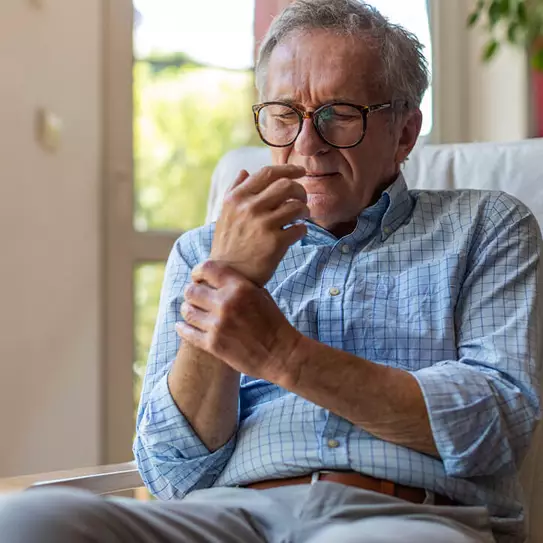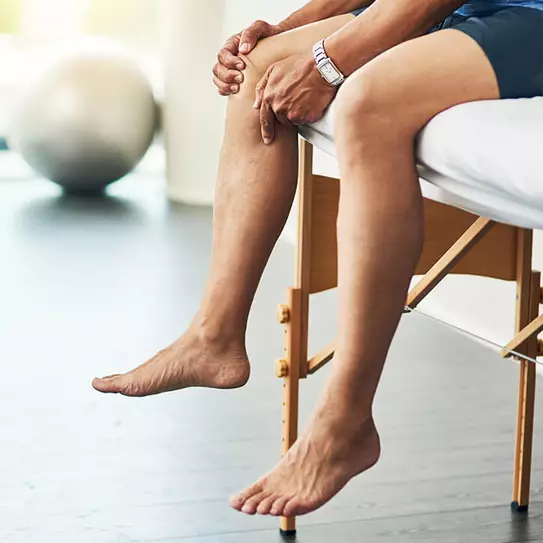
Osteoarthritis (Arthrosis deformans) is the world’s most common non-inflammatory joint disease. Osteoarthritis is primarily characterised by a deterioration of articular cartilage, from which bone damage of the affected joint can result in the further course.
Osteoarthritis develops slowly and is among the degenerative diseases. Elderly people frequently complain about the wear of a joint, but it does not have to be an inevitable sign of old age.
What happens during the course of osteoarthritis? First the articular cartilage loses its elasticity, becomes soft and breaks down. Cartilage is worn down and leads to painful inflammations of the synovial membrane. Sometimes more bone substance can form on the joint margins in order to compensate for the diminishing cartilage. The surrounding soft tissue is also impaired and restricts the joint’s mobility.
Osteoarthritis can affect all joints, but patients most frequently complain about pain in the knee joints, finger joints, ankles or hip joints, because these joints are usually the most strained. If several joints are affected by wear at the same time, this is referred to as polyosteoarthritis.
According to estimates, at least 5 million people in Germany are affected, whereby almost everyone over age 75 is affected by osteoarthritis.
Causes and prevention of osteoarthritis
Osteoarthritis can have many causes. We have the possibility to avoid some of these causes beforehand and therefore to prevent osteoarthritis. But in general it can be said that all excessive strains on the joints are adverse factors for the development of osteoarthritis.
Being overweight is among the obvious excessive strains on the joints, because the greater the weight that burdens the musculoskeletal system is, the greater the deterioration also is.
But the burden is also increased through a hereditary predisposition, malposition of joints (for example valgus or varus deformity) or injuries such as cruciate ligament or meniscus ruptures. Physical labour, competitive sports or sports with fast, abrupt movements and turns can also contribute to the fact that the cartilage is worn down and can no longer perform its buffering function in the long run.
But lack of exercise is also not good for the joints, because the cartilaginous tissue is itself not supplied with blood, but obtains its nutrients exclusively from the synovial fluid. The synovial fluid (synovia) is itself only exchanged through the movement of the joint.
But osteoarthritis can also be caused or intensified by other diseases. For example, this includes metabolic disorders such as diabetes or gout. But chronic joint inflammations (arthritis) can also subsequently lead to osteoarthritis.
Osteoarthritis cannot be basically classified as a hereditary disease, but genetic factors such as the composition of articular cartilage are hereditary.
Symptoms of osteoarthritis
Cartilage degradation itself actually cannot be felt at first, but its consequences are perceptible. In particular, so-called “morning stiffness” and “start-up pain” are frequently mentioned symptoms of osteoarthritis.
Pains after and during physical activity can then severely restrict the quality of life in the later course of the disease. Frequent cracking and crunching sounds caused by abraded cartilage particles in the articular space can be indicative of osteoarthritis. Those individuals affected typically report alternating intensively painful phases. Inflammations, deformations and restrictions of joint mobility are then the advanced symptoms of osteoarthritis.
You should consult a doctor if you have the following possible symptoms of osteoarthritis:
- Morning stiffness
- Start-up pain (pains which subside later)
- Pains during exertion
- Joint sounds
- Pain at rest and at night
- Swelling and reddening of joints
- Sensitivity to changes in the weather
- Movement restrictions
Diagnosis of osteoarthritis
Anyone who suffers from the typical symptoms of osteoarthritis is in good hands with an orthopaedist. After thorough consultation and a physical examination, an X-ray image can provide further information.
However, X-ray image only show already pronounced joint damage and does not provide any conclusion with regard to the patient’s severity of complaints. That is why better imaging examinations such as computed tomography (CT) or magnetic resonance imaging (MRI) can be included in the event of unclear results. But these procedures are usually not applied in the early stage of a degenerative joint disease due to high costs.
Treatment of osteoarthritis
Unfortunately, it is not possible to completely restore damaged cartilage. Osteoarthritis cannot be causally healed. The treatment of osteoarthritis is consequently limited to relieving painful symptoms, preserving or even improving mobility and avoiding further ailment.
Conservative treatment usually includes adapted physiotherapy, the use of aids such as bandages or dressings and the cooling of inflamed joints or heat treatments for already chronic courses of disease.
Painkillers and/or anti-inflammatory drugs are prescribed in the event of acute joint pains. But medicinal treatment should not be applied as long-term therapy. Cortisone preparations can also be injected directly into the joint in the event of very painful courses of disease.
Regular, adapted and pain-free exercise is particularly important in the treatment of osteoarthritis, because the cartilage protecting the bone is only supplied with the necessary nutrients through regular exercise.
Anyone who suffers from being overweight should urgently try to lose weight, because every kilogram “too much” additionally burdens the bones!
Surgical measures should only be taken into consideration if the conservative treatment of osteoarthritis does not bring about an effect and all other measures were unsuccessful. These surgical measures can be artificial joints (total endoprosthesis/TEP) or else ankylosis (arthrodesis).
The topic of joint health is so complex and important that we have dedicated a separate website, “Arthrose-Special” (“Osteoarthritis Special”) to joints. Here you will find many valuable tips for preserving the health of your joints, particularly the knee joint.
